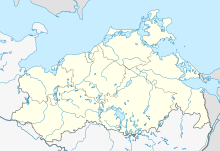Krummenhagener See nature reserve
Coordinates: 54 ° 14 '26 " N , 13 ° 1' 42.3" E
The Krummenhagener See nature reserve is a 263 hectare nature reserve in Mecklenburg-Western Pomerania, about eight kilometers south of the Hanseatic city of Stralsund . Surrounding places are Krummenhagen , Negast and Zarrendorf . The area is touched to the west by federal highway 194 . According to EU law, the areas are part of the FFH area Krummenhagener See, Borgwallsee and Pütter See and the bird sanctuary in North Western Pomerania . The expulsion took place on October 3, 1941 mainly because of the high avifaunistic importance.
The state of the area is rated as satisfactory. A dam built in 1994 keeps the water level constant.
The drivable Krummenhagener Damm leads through the area. A viewing pulpit allows views of the open water area.
History and water balance
The Krummenhagener See was created during the last ice age within a sand area . Meltwater from the thawing glacier flowed through the area and carved out the deepening of today's lake area. In the following millennia, up to three meters thick muds filled the drainless lake, on which peat grew to a small extent. Today's lake depths are often less than 0.5 meters. Human use has been documented by the Neuenkamp monastery since the 13th century . The lake was used for fishing and dammed for the operation of water mills in Stralsund, with the lake water flowing off over the Mühlengraben, Borgwallsee and Pütter See . A water mill was also operated directly at the lake outlet until 1859. When the mill was abandoned, the lake level was lowered. The extent of the free water area decreased sharply. The then 250 hectare lake was divided into six individual open water areas. The silting up of the eutrophic lake accelerated. Two pumping stations pump water from the adjacent fen areas into the lake, which is then drained into the Borgwallsee via the Mühlengraben.
Flora and fauna
The majority of the lake is occupied by reed stands with reeds . Diatoms , horn leaves , crested pondweed , water hose , frog bites and pond roses grow in the individual lakes . Crabs live in the lake. At the southern edge, the lake turns into a break forest.
The occurrence of white-tailed eagles and ospreys are significant from an ornithological point of view . Breeding birds in the nature reserve are marsh harrier , gray goose , red-necked grebe , reed warbler , bearded tit , common snipe , water rail , Savi and Warbler , crane and bittern . The large open water areas are important resting places of many water birds such as gray, seeds and white-fronted goose , singing and Tundra Swan . The otter lives in the area.
literature
- Krummenhagener See 18 . In: Ministry of Environment Mecklenburg-Western Pomerania (Hrsg.): The nature reserves in Mecklenburg-Western Pomerania . Demmler-Verlag, Schwerin 2003, ISBN 3-910150-52-7 , p. 204 f .
Web links
- Literature about the nature reserve Krummenhagener See in the state bibliography MV
- Map portal environment of the State Office for the Environment, Nature Conservation and Geology Mecklenburg-Western Pomerania ( information ) with geodata
- Bike tour along the Krummenhagener See
- Brief presentation with photo on the website of the State Office for Agriculture and Environment, Western Pomerania
Individual evidence
- ↑ Standard data sheet for the FFH area Krummenhagener See, Borgwallsee and Pütter See ( PDF ; 57 kB)
- ↑ Standard data sheet for the EU bird sanctuary North Western Pomerania Forest Landscape ( PDF ; 86 kB)
- ↑ Biotope data sheet Eastern Krummhagener See ( PDF ; 28 kB)
- ↑ Biotope data sheet Black Alder Break on the southern edge of the Krummhagener See ( PDF ; 21 kB)




